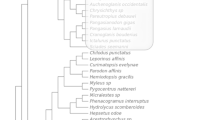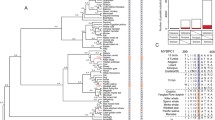Abstract
Hepcidin is a small cysteine-rich peptide that plays an important role in antimicrobial activity and in maintaining iron homeostasis in vertebrates. Here we report on the underlying mechanism that maintains high sequence diversities among the hepcidin-like variants of perciform and pleuronectiform fishes. In contrast to mammals, maximum likelihood-based codon substitution analyses revealed that positive Darwinian selection (nonsynonymous to synonymous substitution, ω > 1) is the likely cause of accelerated rate of amino acid substitutions in the hepcidin mature peptide region of these fishes. Comparison of models incorporating positive selection (ω > 1) at certain sites with models not incorporating positive selection (ω < 1) failed to reject (p = 0) the evidence of positive selection among the codon sites of percifom and pleuronectiform hepcidin. The adaptive evolution of this peptide in perciform and pleuronectiform fishes might be directed by pathogens when the host is exposed to new habitats/environments.
Similar content being viewed by others
Abbreviations
- AMP:
-
Antimicrobial peptide
- ML:
-
Maximum likelihood
- BI:
-
Bayesian inference
- NJ:
-
Neighbour joining
- JTT:
-
Jones-Taylor-Thornton
- dN :
-
Nonsynonymous nucleotide substitutions per nonsynonymous site
- dS :
-
Synonymous substitutions per synonymous site
- ω :
-
dN/dS
- HKY:
-
Hasegawa-Kishino-Yano
- AIC:
-
Akaike Information Criterion
- hLR:
-
Hierarchical likelihood ratio test
- Γ:
-
Invariable sites
- γ :
-
Gamma distribution shape parameter
References
Chen S, Li W, Meng L, Sha Z, Wang Z and Ren G (2007). Molecular cloning and expression analysis of a hepcidin antimicrobial peptide gene from turbot (Scophthalmus maximus). Fish Shellfish Immunol 22: 172–181
Douglas S, Gallant J, Liebscher R, Dacanay A and Tsoi S (2003). Identification and expression analysis of hepcidin-like antimicrobial peptides in bony fish. Dev Comp Immunol 27: 589–601
Lauth X, Babon J, Stannard J, Singh S, Nizet V, Carlberg J, Ostland Ve, Penningnton MW, Norton RS and Westerman SE (2005). Bass hepcidin synthesis, solution structure, antimicrobial activities and synergism, and in vivo hepatic response to bacterial infections. J Biol Chem 280: 9272–9282
Lehrer RI and Ganz T (1999). Antimicrobial peptides in mammalian and insect host defence. Curr Opin Immunol 11: 23–27
Rodrigues P, Vazquez-Dorado S, Neves J and Wilson J (2006). Dual function of fish hepcidin: response to experimental iron overload and bacterial infection in sea bass (Dicentrarchus labrax). Dev Comp Immunol 30: 1156–1167
Shike H, Shimizu C, Lauth X and Burns JC (2004). Organization and expression analysis of the zebrafish hepcidin gene, an antimicrobial peptide gene conserved among vertebrates. Dev Comp Immunol 28: 747–754
Bowman HG (2003). Antibacterial peptides: basic facts and emerging concepts. J Intern Med 254: 197–215
Hedengren M, Borge K and Hultmark D (2000). Expression and evolution of the Drosophila Attacin/Diptericin gene family. Biochem Biophys Res Comm 279: 574–581
Tennessen JA (2005). Molecular evolution of animal antimicrobial peptides: widespread moderate positive selection. J Evol Biol 18: 1387–1394
Nicolas P, Vanhoye D and Amiche M (2003). Molecular strategies in biological evolution of antibacterial peptides. Peptides 24: 1669–1680
Padhi A, Verghese B, Otta S, Varghese B and Ramu K (2007). Adaptive evolution after duplication of penaeidin antimicrobial peptides. Fish Shellfish Immunol 23: 553–566
Kimura M (1983). The neutral theory of molecular evolution. Cambridge University press, New York
Bulmer M and Crozier R (2004). Duplication and diversifying selection among termite antifungal peptides. Mol Biol Evol 21: 2256–2564
Duda TJ, Vanhoye D and Nicolas P (2002). Roles of diversifying selection and coordinated evolution in the evolution of Amphibian antimicrobial peptides. Mol Biol Evol 19: 858–864
Hughes A and Yeager M (1997). Coordinated amino acid changes in the evolution of mammalian defensins. J Mol Evol 44: 675–685
Semple C, Rolfe M and Dorin J (2003). Duplication and selection in the evolution of primate β-defensin genes. Genome Biol 4: R31
Shi J and Camus A (2006). Hepcidins in amphibians and fishes: Antimicrobial peptides or iron-regulatory hormones?. Dev Comp Immunol 30: 746–755
Shike H, Lauth X, Westerman ME, Ostland VE, Carlberg JM, Olst JCV, Shimizu C, Bulet P and Burns JC (2002). Bass hepcidin is a novel antimicrobial peptide induced by bacterial challenge. Eur J Biochem 269: 2232–2237
Brogden KA (2005). Antimicrobial peptides: pore formers or metabolic inhibitors in bacteria?. Nat Rev Microbiol 3: 238–250
Hunter HN, Fultons DB, Ganz T and Vogel HJ (2002). The solution structure of human hepcidin, a peptide hormone with antimicrobial activity that is involved in iron uptake and hereditary hemochromatosis. J Biol Chem 277: 37597–37603
Hirono I, Hwang J, Ono Y, Kurobe T, Ohira T, Nozaki R and Takashi A (2005). Two different types of hepcidins from the Japanese flounder Paralichthys olivaceus. FEBS J 272: 5257–5264
Chen S, Xu M, Ji X, Yu G and Liu Y (2005). Cloning, characterization, and expression analysis of hepcidin gene from red sea bream (Chrysophrys major). Antimicrob Agents Chemother 49: 1608–1612
Kim Y, Hong S, Nam B, Lee J, Kim K and Lee S (2005). Molecular cloning and expression analysis of two hepcidin genes from olive flounder Paralichthys olivaceus. Biosci Biotechnol Biochem 69: 1411–1414
Ren H, Wang K, Zhou H and Yang M (2006). Cloning and organisation analysis of a hepcidin-like gene and cDNA from Japan sea bass, Lateolabrax japonicus. Fish Shellfish Immunol 3: 221–227
Ford M (2002). Applications of selective neutrality tests to molecular ecology. Mol Ecol 11: 1245–1262
Hughes AL and Nei M (1989). Nucleotide substitution at major histocompatibility complex class II loci: evidence for overdominant selection. Proc Natl Acad Sci USA 86: 958–962
Yang Z, Nielsen R, Goldman N and Pederson A (2000). Codon-substitution models for heterogeneous selection pressures at amino acid sites. Genetics 155: 431–449
Xia X (2000). Data analysis in molecular biology and evolution. Kluwer Academic Publishers, Boston
Xia X and Xie Z (2001). DAMBE: Data analysis in molecular biology and evolution. J Heredity 92: 371–373
Hall T (1999). BioEdit: a user friendly biological sequence alignment editor and analyses program for windows 95/98/N.T. Nucl Acids Symp Ser 41: 95–98
Maddison Y, Maddison D, Mesquite: A modular system for evolutionary analysis. Version 1.12. http://mesquiteproject.org. 2006
Guindon S and Gascuel O (2003). A simple, fast and accurate algorithm to estimate large phylogenies by maximum likelihood. Syst Biol 52: 696–704
Huelsenbeck J and Ronquist F (2001). MRBAYES: Bayesian inference of phylogenetic trees. Bioinformatics 17: 754–755
Kumar S, Tamura K and Nei M (2004). MEGA3.1: Integrated software for Molecular Evolutionary Genetics Analysis and sequence alignment. Briefings in Bioinformatics 5: 150–163
Rambout A, Drummond A, Tracer. Version 1.3 Available from http://evolve.zoo.ox.ac.uk/. In, 2003
Yang Z (1997). PAML: a program package for phylogenetic analysis by maximum likelihood. Comput Appl Biosci 13: 555–556
Posada D and Crandall K (1998). Modeltest: testing the model of DNA substitution. Bioinformatics 14: 817–818
Swofford DL, PAUP*. Phylogenetic analysis using parsimony (and other methods) ver. 4.0.10b. Sunderland: Sinauer Associates, 2002
Rozas J, Sánchez-DelBarrio JC, Messeguer X and Rozas R (2003). DnaSP, DNA polymorphism analyses by the coalescent and other methods. Bioinformatics 19: 2496–2497
Morrison G, Semple C, Kilanowski F, Hill R and Dorin J (2003). Signal sequence conservation and mature peptide divergence within subgroups of the murine β-defensin gene family. Mol Biol Evol 20: 460–470
Yang Z (1998). Likelihood ratio tests for detecting positive selection and application to primate lysozyme evolution. Mol Biol Evol 15: 568–573
Swanson W, Nielsen R and Yang Q (2003). Pervasive adaptive evolution in mammalian fertilization proteins. Mol Biol Evol 20: 18–20
Yang Z, Wong W and Nielsen R (2005). Bayes empirical Bayes inference of amino acid sites under positive selection. Mol Biol Evol 22: 1107–1118
Maddison WP (1997). Gene trees in species trees. Syst Biol 46: 523–536
Tennessen JA (2005). Enhanced synonymous site divergence in positively selected vertebrate antimicrobial peptide genes. J Mol Evol 61: 445–455
Author information
Authors and Affiliations
Corresponding author
Rights and permissions
About this article
Cite this article
Padhi, A., Verghese, B. Evidence for positive Darwinian selection on the hepcidin gene of Perciform and Pleuronectiform fishes. Mol Divers 11, 119–130 (2007). https://doi.org/10.1007/s11030-007-9066-4
Received:
Accepted:
Published:
Issue Date:
DOI: https://doi.org/10.1007/s11030-007-9066-4




